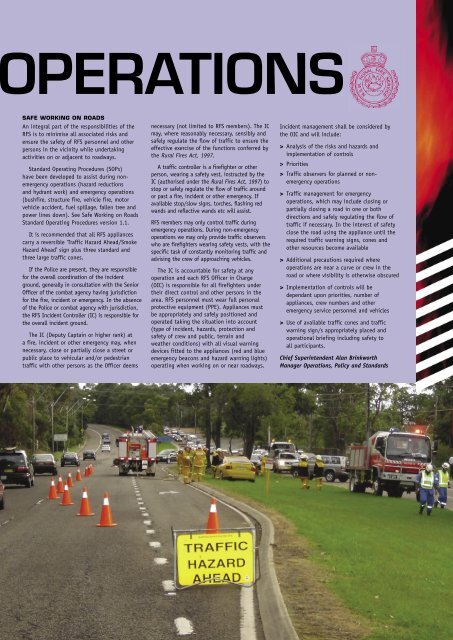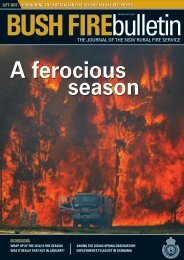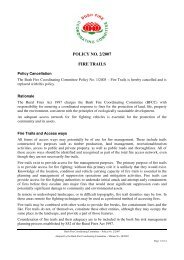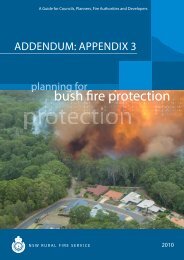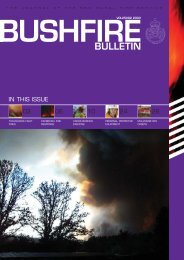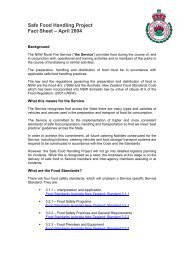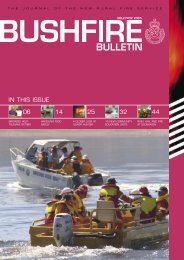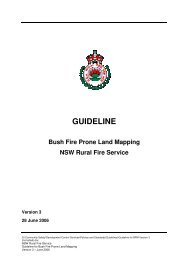to view - NSW Rural Fire Service
to view - NSW Rural Fire Service
to view - NSW Rural Fire Service
You also want an ePaper? Increase the reach of your titles
YUMPU automatically turns print PDFs into web optimized ePapers that Google loves.
PERATIONS<br />
SAFE WORKING ON ROADS<br />
An integral part of the responsibilities of the<br />
RFS is <strong>to</strong> minimise all associated risks and<br />
ensure the safety of RFS personnel and other<br />
persons in the vicinity while undertaking<br />
activities on or adjacent <strong>to</strong> roadways.<br />
Standard Operating Procedures (SOPs)<br />
have been developed <strong>to</strong> assist during nonemergency<br />
operations (hazard reductions<br />
and hydrant work) and emergency operations<br />
(bushfire, structure fire, vehicle fire, mo<strong>to</strong>r<br />
vehicle accident, fuel spillage, fallen tree and<br />
power lines down). See Safe Working on Roads<br />
Standard Operating Procedures version 1.1.<br />
It is recommended that all RFS appliances<br />
carry a reversible ‘Traffic Hazard Ahead/Smoke<br />
Hazard Ahead’ sign plus three standard and<br />
three large traffic cones.<br />
If the Police are present, they are responsible<br />
for the overall coordination of the incident<br />
ground, generally in consultation with the Senior<br />
Officer of the combat agency having jurisdiction<br />
for the fire, incident or emergency. In the absence<br />
of the Police or combat agency with jurisdiction,<br />
the RFS Incident Controller (IC) is responsible for<br />
the overall incident ground.<br />
The IC (Deputy Captain or higher rank) at<br />
a fire, incident or other emergency may, when<br />
necessary, close or partially close a street or<br />
public place <strong>to</strong> vehicular and/or pedestrian<br />
traffic with other persons as the Officer deems<br />
necessary (not limited <strong>to</strong> RFS members). The IC<br />
may, where reasonably necessary, sensibly and<br />
safely regulate the flow of traffic <strong>to</strong> ensure the<br />
effective exercise of the functions conferred by<br />
the <strong>Rural</strong> <strong>Fire</strong>s Act, 1997.<br />
A traffic controller is a firefighter or other<br />
person, wearing a safety vest, instructed by the<br />
IC (authorised under the <strong>Rural</strong> <strong>Fire</strong>s Act, 1997) <strong>to</strong><br />
s<strong>to</strong>p or safely regulate the flow of traffic around<br />
or past a fire, incident or other emergency. If<br />
available s<strong>to</strong>p/slow signs, <strong>to</strong>rches, flashing red<br />
wands and reflective wands etc will assist.<br />
RFS members may only control traffic during<br />
emergency operations. During non-emergency<br />
operations we may only provide traffic observers<br />
who are firefighters wearing safety vests, with the<br />
specific task of constantly moni<strong>to</strong>ring traffic and<br />
advising the crew of approaching vehicles.<br />
The IC is accountable for safety at any<br />
operation and each RFS Officer in Charge<br />
(OIC) is responsible for all firefighters under<br />
their direct control and other persons in the<br />
area. RFS personnel must wear full personal<br />
protective equipment (PPE). Appliances must<br />
be appropriately and safely positioned and<br />
operated taking the situation in<strong>to</strong> account<br />
(type of incident, hazards, protection and<br />
safety of crew and public, terrain and<br />
weather conditions) with all visual warning<br />
devices fitted <strong>to</strong> the appliances (red and blue<br />
emergency beacons and hazard warning lights)<br />
operating when working on or near roadways.<br />
Incident management shall be considered by<br />
the OIC and will include:<br />
> Analysis of the risks and hazards and<br />
implementation of controls<br />
> Priorities<br />
> Traffic observers for planned or nonemergency<br />
operations<br />
> Traffic management for emergency<br />
operations, which may include closing or<br />
partially closing a road in one or both<br />
directions and safely regulating the flow of<br />
traffic if necessary. In the interest of safety<br />
close the road using the appliance until the<br />
required traffic warning signs, cones and<br />
other resources become available<br />
> Additional precautions required where<br />
operations are near a curve or crew in the<br />
road or where visibility is otherwise obscured<br />
> Implementation of controls will be<br />
dependant upon priorities, number of<br />
appliances, crew numbers and other<br />
emergency service personnel and vehicles<br />
> Use of available traffic cones and traffic<br />
warning sign/s appropriately placed and<br />
operational briefing including safety <strong>to</strong><br />
all participants.<br />
Chief Superintendent Alan Brinkworth<br />
Manager Operations, Policy and Standards


